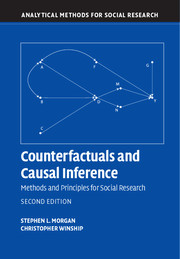Book contents
- Frontmatter
- Dedication
- Contents
- List of Figures
- List of Tables
- Acknowledgments for First Edition
- Acknowledgments for Second Edition
- I Causality and Empirical Research in the Social Sciences
- II Counterfactuals, Potential Outcomes, and Causal Graphs
- 2 Counterfactuals and the Potential Outcome Model
- 3 Causal Graphs
- III Estimating Causal Effects by Conditioning on Observed Variables to Block Back-Door Paths
- IV Estimating Causal Effects When Back-Door Conditioning Is Ineffective
- V Estimation When Causal Effects Are Not Point-Identified by Observables
- VI Conclusions
- References
- Index
2 - Counterfactuals and the Potential Outcome Model
Published online by Cambridge University Press: 05 December 2014
- Frontmatter
- Dedication
- Contents
- List of Figures
- List of Tables
- Acknowledgments for First Edition
- Acknowledgments for Second Edition
- I Causality and Empirical Research in the Social Sciences
- II Counterfactuals, Potential Outcomes, and Causal Graphs
- 2 Counterfactuals and the Potential Outcome Model
- 3 Causal Graphs
- III Estimating Causal Effects by Conditioning on Observed Variables to Block Back-Door Paths
- IV Estimating Causal Effects When Back-Door Conditioning Is Ineffective
- V Estimation When Causal Effects Are Not Point-Identified by Observables
- VI Conclusions
- References
- Index
Summary
In this chapter, we introduce the foundational components of the potential outcome model. We first discuss causal states, the relationship between potential and observed outcome variables, and the usage of the label “counterfactual” to refer to unobserved potential outcomes. We introduce average causal effects and then discuss the assumption of causal effect stability, which is maintained explicitly in most applications that use the potential outcome model. We discuss simple estimation techniques and demonstrate the importance of considering the relationship between the potential outcomes and the process of causal exposure. We conclude by extending our presentation to over-time potential outcome variables for one or more units of analysis, as well as causal variables that take on more than two values.
Defining the Causal States
The counterfactual framework for observational data analysis presupposes the existence of well-defined causal states to which all members of the population of interest could be exposed. As we will show in the next section, causal effects are then defined based on comparisons of outcomes that would result from exposure to alternative causal states. For a binary cause, the two states are usually labeled treatment and control. When a many-valued cause is analyzed, the convention is to refer to the alternative states as alternative treatments.
Although these labels are simple, the assumed underlying states must be very carefully defined so that the contribution of an empirical analysis based upon them is clear.
- Type
- Chapter
- Information
- Counterfactuals and Causal InferenceMethods and Principles for Social Research, pp. 37 - 76Publisher: Cambridge University PressPrint publication year: 2014
- 2
- Cited by



